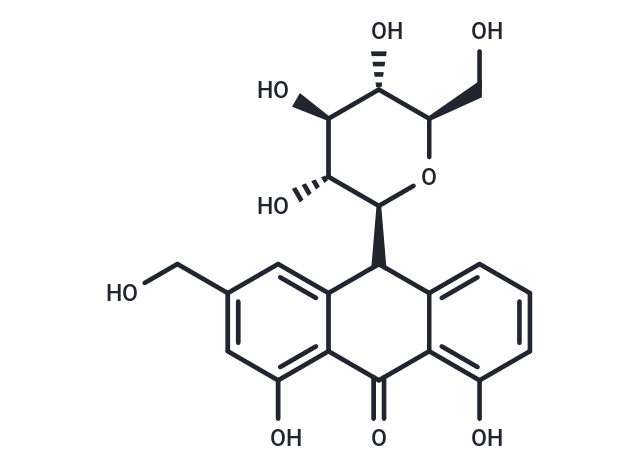Shopping Cart
Remove All Your shopping cart is currently empty
Your shopping cart is currently empty
ALOIN Inhibits Interleukin (IL)-1β-Stimulated IL-8 Production in KB Cells.

| Pack Size | Price | USA Warehouse | Global Warehouse | Quantity |
|---|---|---|---|---|
| 1 mg | $39 | In Stock | In Stock | |
| 5 mg | $88 | In Stock | In Stock | |
| 10 mg | $122 | In Stock | In Stock | |
| 25 mg | $197 | In Stock | In Stock | |
| 50 mg | $278 | In Stock | In Stock | |
| 100 mg | $388 | In Stock | In Stock |
| Description | ALOIN Inhibits Interleukin (IL)-1β-Stimulated IL-8 Production in KB Cells. |
| In vitro | Clostridium histolyticum collagenase (ChC) results dose-dependently inhibited by aloe gel and the activity-guided fractionation led to an active fraction enriched in phenolics and aloins.?Aloins have been shown to be able to bind and to inhibit ChC reversibly and non-competitively.?Aloe gel and aloins are also effective inhibitors of stimulated granulocyte matrix metalloproteinases (MMPs)[1]. |
| In vivo | Aloin effectively inhibits salivary IL-1β-induced IL-8 production by mitigating the p38 and ERK pathway. Therefore, aloin may be a good candidate for modulating oral inflammatory diseases[2]. |
| Animal Research | Saliva was collected from volunteers to determine IL-1β and IL-8 levels. Samples from volunteers were divided into two groups: those with low and those with high IL-1β levels. KB cells were stimulated with IL-1β or saliva with or without IL-1 receptor agonist or specific mitogen-activated protein kinase (MAPK) inhibitors. IL-8 production was measured by enzyme-linked immunosorbent assay (ELISA). MAPK protein expression involved in IL-1β-induced IL-8 secretion was detected by Western blot. KB cells were pretreated with?aloin, and its effect on IL-1β-induced IL-8 production was examined by ELISA and Western blot analysis[1]. |
| Cas No. | 8015-61-0 |
| Smiles | OC[C@H]1O[C@H]([C@H](O)[C@@H](O)[C@@H]1O)C1c2cccc(O)c2C(=O)c2c(O)cc(CO)cc12 |
| Relative Density. | no data available |
| Storage | Powder: -20°C for 3 years | In solvent: -80°C for 1 year | Shipping with blue ice/Shipping at ambient temperature. |
| Solubility Information | DMSO: 50 mg/mL, Sonication is recommended. |
| In Vivo Formulation | 10% DMSO+40% PEG300+5% Tween 80+45% Saline: 2 mg/mL, Sonication is recommended. Please add the solvents sequentially, clarifying the solution as much as possible before adding the next one. Dissolve by heating and/or sonication if necessary. Working solution is recommended to be prepared and used immediately. The formulation provided above is for reference purposes only. In vivo formulations may vary and should be modified based on specific experimental conditions. |
| Size | Quantity | Unit Price | Amount | Operation |
|---|

Copyright © 2015-2025 TargetMol Chemicals Inc. All Rights Reserved.